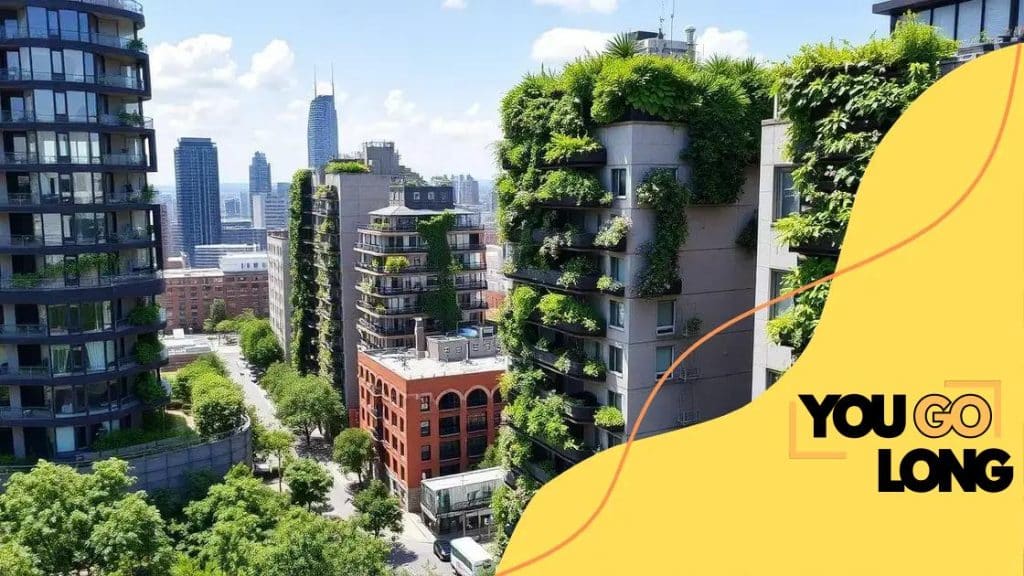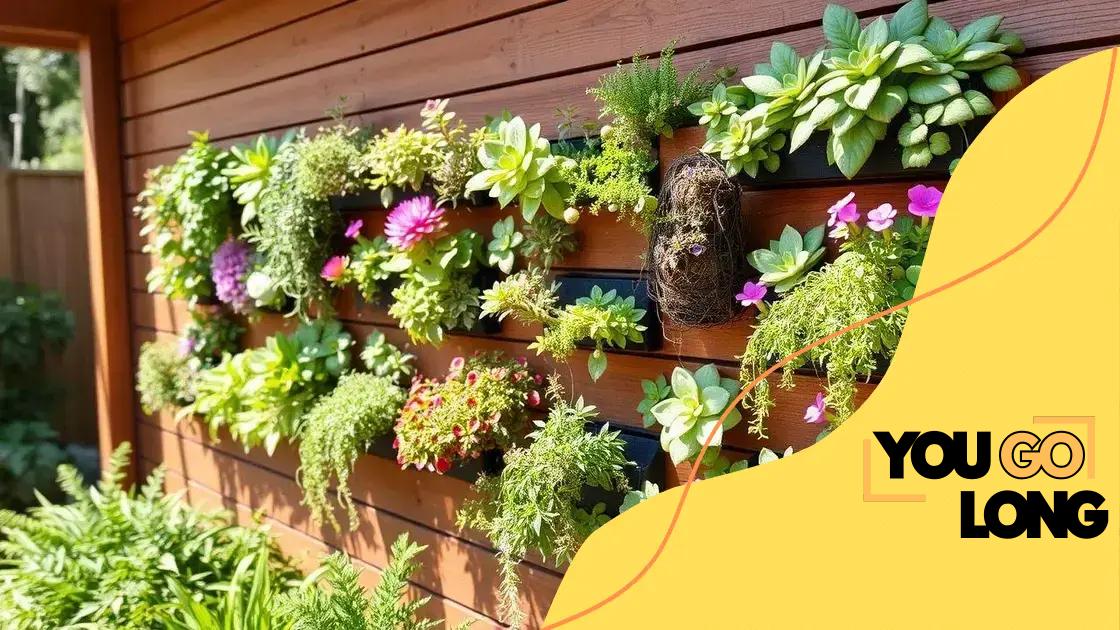The rise of vertical gardens in urban areas

Advertisement
The rise of vertical gardens in urban areas enhances aesthetics, improves air quality, and supports biodiversity, making cities greener and more sustainable.
The rise of vertical gardens in urban areas is reshaping the way we think about city living. Have you ever imagined your city transformed into a lush, green oasis? In this article, we’ll dive into the benefits and the basics of vertical gardening.
Understanding vertical gardens and their components
Understanding vertical gardens is essential for anyone interested in enhancing urban spaces. These innovative structures allow us to incorporate greenery in limited spaces, making cities feel more alive.
Vertical gardens consist of various components that work together to create a thriving ecosystem. Let’s explore these components and understand how they contribute to the success of vertical gardening.
Advertisement
Key Components of Vertical Gardens
The main elements of a vertical garden include:
- Structure: This is the framework that supports the plants. It can be made from wood, metal, or even recycled materials.
- Growing Medium: Plants need soil or another growing medium to thrive. Vertical gardens often use lightweight substrates that promote healthy growth.
- Plants: Choosing the right plants is crucial. Look for species that can thrive in vertical settings, such as ferns, succulents, and herbs.
- Irrigation System: A proper watering system ensures that plants get the moisture they need. Drip irrigation is a popular choice for vertical gardens.
These components work together to create a visually stunning and functional garden. The structure should not only support the plants but also blend seamlessly into the urban environment.
Plant selection plays a vital role in the garden’s success. Consider factors like sun exposure and climate when choosing plants for your vertical garden. Seasonal changes can also affect plant health, so select species adaptable to varying conditions.
Advertisement
Maintaining a vertical garden requires regular care. Watering, pruning, and fertilizing are essential tasks to keep your plants healthy and vibrant. Understanding the specific needs of your chosen plants can greatly enhance their growth.
Vertical gardens not only add beauty but also improve air quality and provide insulation for buildings. They can transform dull walls into captivating green spaces while offering numerous environmental benefits.
Benefits of Vertical Gardens
- Improved air quality
- Enhanced aesthetics in urban areas
- Reduction of building temperatures
- Opportunities for urban farming
In conclusion, understanding the components of vertical gardens helps us appreciate their role in urban environments. These gardens are more than just beautiful; they are a step toward sustainable living in cities.
Benefits of vertical gardens in urban settings
Vertical gardens offer numerous benefits in urban settings, making them an attractive choice for city dwellers and planners. These green spaces can transform concrete jungles into vibrant ecosystems.
One of the most significant benefits is the improvement of air quality. Plants naturally filter pollutants and produce oxygen, making city air cleaner. In addition, vertical gardens can help reduce noise pollution by acting as sound barriers in busy urban areas.
Environmental Benefits
Vertical gardens have a positive impact on the urban environment in various ways:
- Temperature Regulation: Plants provide shade and help cool buildings, reducing the urban heat island effect.
- Biodiversity: They create habitats for birds, insects, and other wildlife, enhancing biodiversity in cities.
- Stormwater Management: Vertical gardens absorb rainwater, which helps to reduce runoff and prevent flooding.
- Carbon Sequestration: By trapping carbon dioxide, plants contribute to mitigating climate change.
Moreover, vertical gardens enhance the aesthetic appeal of buildings and public spaces. They add beauty and color, making urban areas more inviting. People are often drawn to green spaces, which can encourage outdoor activities and community engagement.
Health and Well-being are also positively influenced by vertical gardens. Greenery has been shown to reduce stress, improve mental health, and boost overall well-being. Access to nature, even in small doses, can rejuvenate city life.
Economic Benefits
Implementing vertical gardens can lead to economic advantages as well. These gardens can increase property values by enhancing curb appeal. Businesses near green spaces often experience higher foot traffic, leading to increased sales.
Furthermore, vertical gardens can promote sustainable practices by encouraging urban farming. Residents can grow their own food, contributing to food security in cities.
In summary, the benefits of vertical gardens in urban settings are abundant. They improve air quality, enhance aesthetics, promote biodiversity, and support mental health—all while providing economic advantages. Integrating these gardens into city planning is a step toward a more sustainable and vibrant urban future.
Designing your own vertical garden

Designing your own vertical garden can be a rewarding creative project. It allows you to express your style while enhancing your living space. The great news is that you don’t need a lot of space to create something beautiful.
Before you start, it’s essential to plan your vertical garden. Consider the location first. Do you want it indoors or outdoors? Check the amount of sunlight the area receives. Some plants thrive in bright light, while others prefer shade.
Choosing the Right Plants
Choosing the right plants is crucial for a successful vertical garden. Here are some easy-to-grow options:
- Succulents: These require less water and are perfect for sunny spots.
- Ferns: Ideal for shady areas, they add lush greenery.
- Herbs: Grow basil, mint, or thyme for a functional vertical garden.
- Flowering Plants: Incorporate colorful flowers for added beauty.
Once you’ve selected your plants, it’s time to think about the design. A simple trellis can support climbing plants while creating a visually pleasing layout. You can also use wall-mounted planters or pocket systems for a modern touch.
Watering systems are important as well. A drip irrigation system can help keep plants hydrated without overwatering. If you set it up correctly, it can save you time and ensure your plants receive adequate moisture.
Building Your Vertical Garden
Your vertical garden can be built using various materials. Wood frames work well, but you can also use recycled pallets for an eco-friendly approach. Plastic or metal planters can add a modern flair. Remember to make drainage holes in your containers to prevent waterlogging.
As you assemble your garden, think about layering plants by height. Taller plants can go at the back, while smaller ones can be placed in the front. This arrangement not only looks attractive but also ensures that all plants receive sunlight.
Echoing nature is wonderful; incorporate natural elements like stones or driftwood for added texture. Personalized features make your garden unique, so don’t hesitate to be creative!
Creating a vertical garden is a fun and practical way to beautify your space. With a little planning and creativity, you’ll have a thriving green wall that lifts the atmosphere of your home or office.
Maintenance tips for urban vertical gardens
Maintaining an urban vertical garden is essential for keeping it healthy and thriving. Regular care ensures your plants stay vibrant and visually appealing. With the right tips, you can easily manage your vertical garden.
Watering is one of the most important tasks. It’s crucial to monitor your plants’ water needs. On hot days, you may need to water more frequently. A good rule is to check the soil; if it feels dry an inch below the surface, it’s time to water. Consider setting up an automated irrigation system to simplify this process.
Fertilizing Your Vertical Garden
Another key component of maintenance is fertilizing. Use a balanced fertilizer every few weeks during the growing season. This will provide your plants with essential nutrients they need to flourish. For organic options, consider compost or worm castings.
- Organic Fertilizers: These are great for promoting healthy growth without chemicals.
- Liquid Fertilizers: They can be mixed with water, making them easy to apply.
- Slow-release Fertilizers: These provide nutrients over an extended period, reducing the frequency of application.
Pruning is another essential task. Regular trimming encourages healthy growth and prevents overcrowding. By cutting back any dead or yellowing leaves, you can promote better air circulation and light penetration. Use sharp, clean scissors to make precise cuts.
Pest Management
Keep an eye out for pests as well. Common pests include aphids, spider mites, and whiteflies. If you notice any infestations, act quickly. Natural insecticides or homemade solutions, such as neem oil, can effectively manage these problems.
Mulching is also beneficial. Adding a layer of mulch helps retain moisture and suppress weeds. This can be particularly useful in vertical gardens where plants are competing for resources.
Lastly, seasonal care is crucial. As seasons change, so do the needs of your plants. Prepare for winter by bringing sensitive plants indoors and insulating those left outside. In spring, prune and refresh your garden to kick off the growing season.
With these maintenance tips, your urban vertical garden can thrive, providing you with beauty and fresh air all year round.
Case studies of successful vertical gardens
Exploring case studies of successful vertical gardens provides valuable insights into how these green spaces can thrive in urban environments. Many cities around the world have embraced vertical gardening, showcasing impressive installations.
One notable example is the Green Wall at the CaixaForum in Madrid, Spain. This stunning vertical garden, designed by botanist Patrick Blanc, features over 15,000 plants of various species. It not only enhances the building’s aesthetic but also helps improve air quality and provides insulation. The wall absorbs rainwater, reducing runoff and promoting sustainability.
The One Central Park in Sydney
Another striking example is the One Central Park development in Sydney, Australia. This project incorporates lush vertical gardens designed by the renowned architect Frank Gehry. The gardens feature over 35,000 individual plants, creating a vibrant living façade. This approach fosters biodiversity while offering residents a green view in the middle of the city.
Vertical gardens like these not only beautify urban areas but also contribute positively to the environment. They can reduce building energy use by providing insulation and improving air quality.
City of Paris Vertical Gardens
In Paris, several vertical garden projects are flourishing. One of the most famous is the Mur Vegetal by Patrick Blanc, located on the side of the Musée du Quai Branly. This immersive green wall integrates native plants that reflect the diversity of the ecosystem.
Beyond aesthetics, successful vertical gardens attract wildlife, including birds and insects, which play essential roles in maintaining environmental health.
Moreover, these gardens can inspire urban farming initiatives. For example, the famous VertiCrop system in Canada demonstrates how vertical gardens can yield fresh produce while conserving space. This innovative approach has gained popularity in urban areas, promoting local food production.
Successful Community Projects
Many community gardens have also utilized vertical gardening methods to maximize limited space. Local neighborhoods are engaging in gardening projects that enhance community ties while promoting sustainability. These vertical gardens provide fresh herbs and vegetables, helping to address food security.
The success of these case studies proves that vertical gardens are not just about aesthetics; they can transform urban landscapes, enhance biodiversity, and contribute to a healthier environment.
FAQ – Frequently Asked Questions about Vertical Gardens
What are vertical gardens?
Vertical gardens are innovative green structures where plants grow on a vertical surface, enhancing urban spaces and improving air quality.
What benefits do vertical gardens provide?
They improve air quality, support biodiversity, enhance aesthetics, and promote community engagement.
How can I maintain my vertical garden?
Key maintenance tasks include regular watering, fertilizing, pruning, and monitoring for pests.
Can vertical gardens be created in small spaces?
Yes, vertical gardens are perfect for small spaces as they utilize vertical surfaces, maximizing greenery without needing a large footprint.





